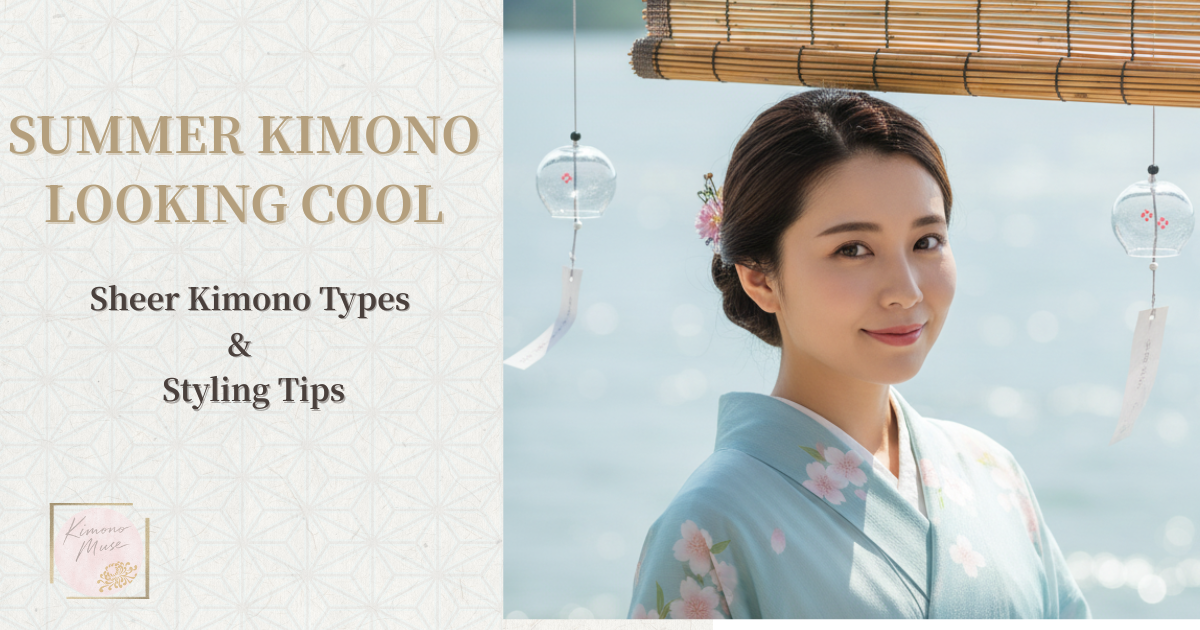In Japan, where the four seasons are distinct, there is a traditional custom called koromogae—changing one’s wardrobe to suit the season.
Kimono follow this same practice, with fabrics and tailoring chosen according to the time of year.
In midsummer, people wear usumono, or summer kimono, made from airy fabrics.
These garments, which softly filter the summer light, bring a light, breezy texture and a cool feel, adding elegance to the Japanese summer.
In this article, we explore the charm of usumono, the unique qualities of different fabrics, and tips on selecting obi and accessories to make your seasonal ensemble even more enjoyable.
What is Usumono?
Usumono refers to a type of kimono worn from midsummer to early autumn, characterized by its sheer, airy appearance.
Woven from breathable, lightweight materials such as sha (gauze weave), ro (open weave), or hemp, these garments create a refreshingly cool impression.
Designed to be even lighter and cooler than hitoe (unlined kimono), usumono have long been favored during Japan’s hottest months.
One of their charms is the ability to enjoy color coordination between the sheer outer fabric and the layers beneath—such as the nagajuban (under-kimono), obi, and accessories.
Difference Between Usumono and Yukata
Even though both are summer attire, usumono and yukata differ in their purpose and manner of wear.
The yukata is the only type of traditional Japanese clothing considered acceptable to wear directly against the skin. In the past, it was also used as indoor wear or sleepwear.
Because of this, it can be worn without a hadajuban or nagajuban (under-kimono), making it a casual and easy option. Yukata are typically paired with casual obi such as hanhaba obi or heko obi, and worn barefoot with geta sandals.
Usumono, on the other hand, are worn over a nagajuban, with obi and accessories coordinated for a more formal, season-appropriate look. This gives them a refined and elegant appearance, suitable for occasions such as tea gatherings or theater performances—situations where yukata might be considered too casual.
While it is possible to style a yukata in a more kimono-like manner, it is generally safe to think of yukata as more casual than usumono.
| Item | Yukata | Usumono |
|---|---|---|
| Worn Season | Mainly midsummer (July–August) | Midsummer to early autumn (July–September) |
| Occasions | Summer festivals, fireworks displays, casual outings, also as indoor wear or sleepwear | Tea gatherings, theater, formal dining, and other dressier summer occasions |
| Undergarments (Nagajuban) | Not required (can be worn directly on the skin) | Required (worn over a nagajuban) |
| Types of Obi | Casual obi such as hanhaba obi or heko obi | Formal summer obi such as ro, sha, or tsumugi obi |
| Footwear | Barefoot with geta sandals | Zori sandals worn with tabi socks |
| Formality | Casual | More formal |
| Materials | Mostly cotton or synthetics | Breathable fabrics such as silk (ro, sha), hemp, or synthetics |
| Features | Easy to move in, cool, and comfortable for casual wear | Sheer, lightweight, and elegant in appearance |
Types and Uses of Usumono Kimono
Usumono kimono are designed with features that allow the wearer to stay cool and comfortable during the height of summer.
The texture and appearance vary depending on the fabric and weaving method, and each type is suited to different occasions.
Here, we introduce some of the most common types.
▶ For Formal Wear
| Type | Features | Main Uses |
|---|---|---|
| Ro (絽) | Woven with deliberate gaps between the warp and weft threads, creating distinctive horizontal stripes with a sheer effect. Cool and refined in appearance. | Homongi (visiting wear), tsukesage, plain-dyed kimono, summer nagabakama |
| Ro Chirimen (絽縮緬) | A soft, lightweight fabric that combines the sheerness of ro with the fine crepe texture of chirimen. Graceful and suitable for formal attire. | Summer formal wear (weddings, tea gatherings, etc.) |
| Sha-awase (紗袷) | A kimono made of sha or ro with a very thin lining. Worn in the transitional period between midsummer and early autumn, combining coolness with formality. | Formal wear for the period between hitoe (unlined) and midsummer |
[Ro Fabric Image]
Ro is a type of karami-ori (leno weave) created by twisting warp and weft threads alternately. Its sheer texture gives a cool appearance, making it suitable for formal and semi-formal wear in midsummer.
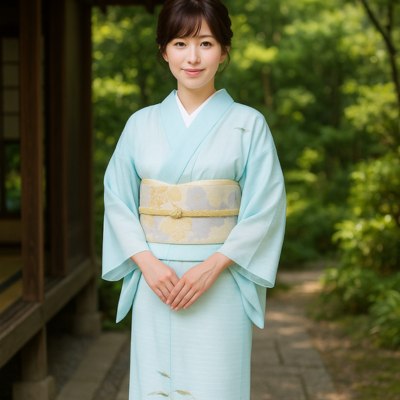
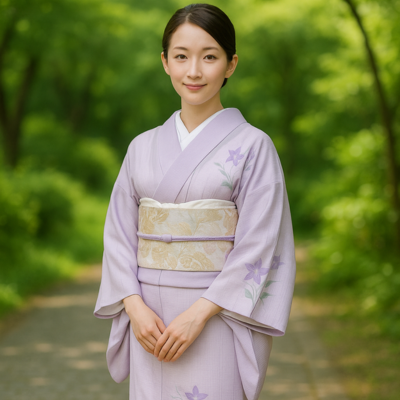
▶ For Casual Wear
| Type | Features | Main Uses |
|---|---|---|
| Sha (紗) | A strongly sheer fabric made with karami-ori (leno weave). Excellent ventilation and light in weight. | Everyday summer wear, stylish casual wear |
| Asa (麻, hemp) | Natural fiber with excellent moisture absorption and quick-drying properties. Smooth texture with a crisp hand. | Casual everyday wear, casual yukata-style outfits |
| Jofu (上布) | High-quality summer kimono woven from fine hemp. Lightweight, soft, with a subtle sheen. | High-end casual wear, luxury summer attire |
| Natsu Tsumugi (夏紬) | A summer version of tsumugi silk, woven with fine threads for a sheer, refreshing texture. | Sophisticated summer wear |
| Natsu Oshima (夏大島) | A summer version of Oshima tsumugi silk, characterized by fine threads and a translucent weave. | Sophisticated summer wear |
| Natsu Shiozawa (夏塩沢) | Lightweight silk fabric from Shiozawa in Niigata, with a crisp texture and translucence. | Casual wear with small patterns or solid colors |
[Sha Fabric Image]
Sha (紗) is a type of karami-ori (leno weave) created by crossing warp and weft threads to form a grid-like open structure. It has a strong sheer quality, is light and breathable, and is used for both formal and casual wear in midsummer.
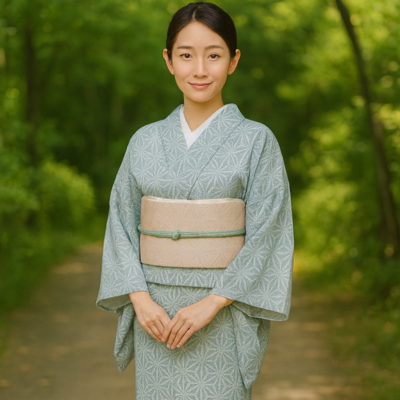
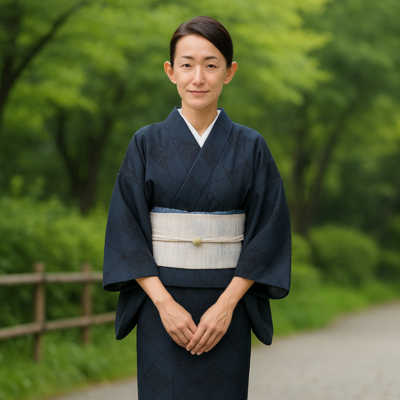
Types and Uses of Obi Suitable for Usumono
For usumono kimono, pairing them with summer-weight obi that have the same sheer quality and lightness enhances both the seasonal feel and the sense of coolness.
Here, we introduce some of the most common types of obi suitable for usumono.
▶ For Formal Wear
| Type of Obi | Features | Main Uses |
|---|---|---|
| Ro Obi (絽帯) | Characterized by horizontal stripe patterns with a sheer texture created through ro weaving. Suitable for formal to semi-formal occasions. | Homongi, tsukesage, plain-dyed kimono, and other summer formal wear |
| Ra Obi (羅帯) | A high-grade obi woven by intertwining multiple threads. Highly sheer with an elegant finish. | Formal summer attire and ceremonial occasions |
| Summer Fukuro Obi (夏袋帯) | A thin, sheer fukuro obi. Used for high-formality occasions. | Weddings, tea gatherings, and similar events |
・White Ra Obi – Adding Cool Elegance to Summer
・Vermilion Ro Tsuzure Obi – Adding Autumn Color
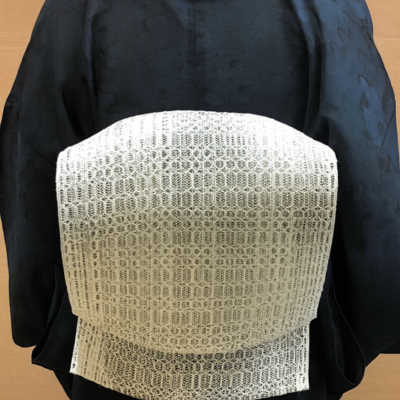
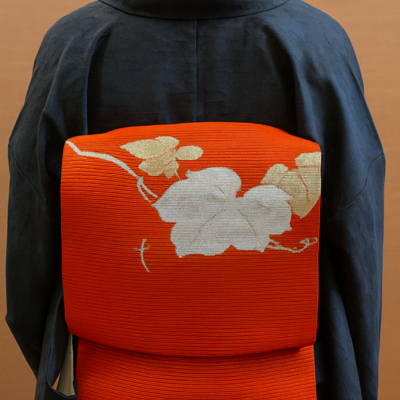
▶ For Casual Wear
| Type of Obi | Features | Main Uses |
|---|---|---|
| Sha Obi (紗帯) | Strongly sheer and lightweight, made with karami-ori (leno weave). | Kimono made of small-patterned, fine-weave, or hemp fabrics |
| Summer Nagoya Obi (夏名古屋帯) | A summer version of the Nagoya obi, woven from ro or sha silk, or hemp. | Hitoe or usumono kimono for sophisticated wear |
| Hanhaba Obi (半幅帯) | Easy to tie and adjust; allows for a variety of creative knots. | Yukata or casual usumono kimono |
・ Cherry Blossom Pink Sha Nagoya Obi – Perfect for Midsummer Attire
・Hemp Eight-Sun Nagoya Obi – Bringing Cool Elegance to Summer
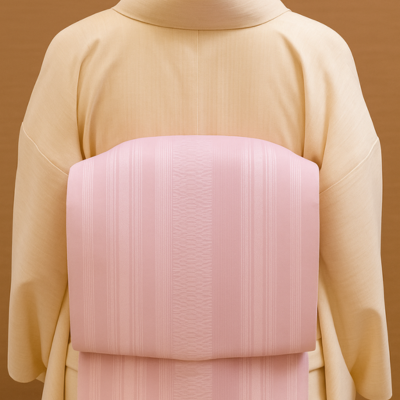
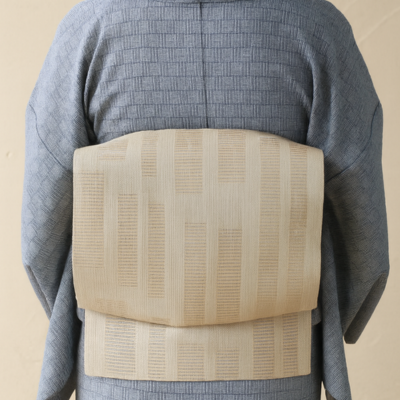
Examples of Usumono and Obi Combinations
To bring out the charm of usumono, it is important to choose an obi that matches the season and the texture of the fabric.
By pairing each usumono—whether formal or casual—with an obi that complements it, you can create a cool, cohesive look.
Here, we present examples of combinations that work especially well together.
▶ For Formal Wear
| Type of Usumono | Features | Main Uses |
|---|---|---|
| Ro Houmongi / Tsukesage(絽 訪問着/付け下げ) | Formal summer kimono made of sheer ro weave; pairs well with light, airy summer obi. | Elegant coordination with a white ro obi and cool-toned obiage and obijime. |
| Ro Chirimen(絽縮緬) | Soft-textured summer chirimen with a subtle sheen. | Light-colored obi to create a refreshing and graceful look. |
| Sha-awase(紗袷) | Sheer sha weave layered for seasonal formality. | Suitable for transitional seasons with a refined impression. |
| Iromuji(色無地:絽・絽縮緬・紗) | Solid-colored summer kimono in ro, ro chirimen, or sha weaves. | Gold/silver-threaded or auspicious-pattern obi for formality; light tones for casual styling. |
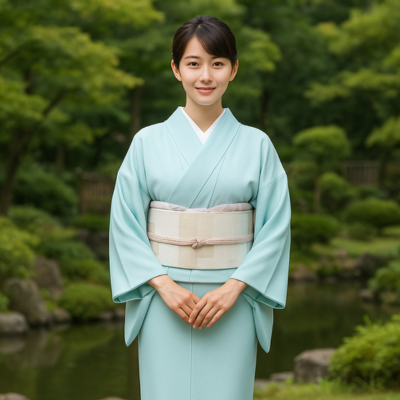
・Light Blue Ro Chirimen Iromuji × Pale-Colored Obi – Elegant Early Summer Coordinatio
Coordinating Obi with Iromuji Kimono
The versatility of iromuji lies in how the choice of obi can take the look from casual to formal.For a casual style, light obi with a touch of pattern—such as hanhaba obi or nagoya obi—are recommended. They are perfect when you want something a little more elegant than everyday wear.For a more formal impression, choose high-grade nagoya obi or fukuro obi featuring gold or silver threads or auspicious motifs. In some cases, the coordination can even appear more formal than a tsukesage.
▶ For Casual Wear
| Type of Usumono | Well-Matched Obi | Coordination Example |
|---|---|---|
| Sha (紗) | Sha Obi, Summer Nagoya Obi | Coordinate with the same karami-ori weave for a light, elegant summer look. |
| Asa (麻) | Summer Nagoya Obi, Hanhaba Obi | Make use of the natural texture for a yukata-like style. |
| Jōfu (上布) | Summer Nagoya Obi, Hanhaba Obi | Combine high-quality fabric with a refreshing color palette. |
| Natsu Tsumugi (夏紬) | Summer Nagoya Obi, Sha Obi | Perfect for midsummer theater outings or strolling around town. |
| Natsu Ōshima (夏大島) | Summer Nagoya Obi, Sha Obi | Pair with solid-color obi to highlight the woven patterns. |
| Natsu Shiozawa (夏塩沢) | Summer Nagoya Obi, Hanhaba Obi | Coordinate for a crisp and refreshing look by highlighting its sharp texture. |
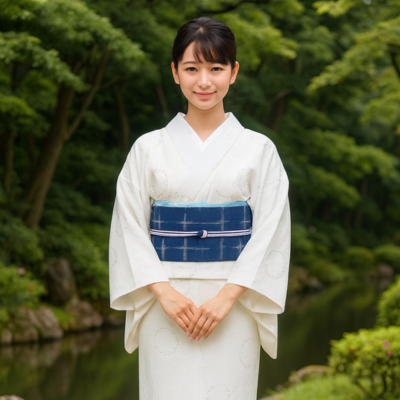
・White Asa Kimono × Indigo Hachisu Obi – A Cool Summer Ensemble
Obi to Match Asa (Hemp) Kimono
Asa kimono tend to be on the casual side, so light and breezy obi pair especially well. The following three types are particularly recommended:
- Hassun Nagoya Obi (Hemp): Creates a light, summery feel.
- Sha Kenjō Hakata Nagoya Obi: Adds a crisp texture and translucence for a refreshing look.
- Natural Material Rustic Obi: Harmonizes with the texture of hemp, giving a cohesive, natural finish.
A core-lined Kyūsun Nagoya Obi in hemp can also add a neat touch, but for Ojiya-chijimi or lighter hemp kimono, more relaxed types like the hassun obi blend in more naturally.
How to Choose Accessories for Usumono
Usumono kimono are admired for their cool impression and sheer texture.
To enhance this look, it is important to choose accessories made from materials and in colors that suit the season.
Here, we share tips on selecting accessories perfect for midsummer.
▶ Obijime

Pairing your outfit with a summer-weight obijime that is thinner or features an openwork weave creates a light and breezy impression. Choosing white or pale colors enhances the sense of coolness, while using an accent color adds definition to the coordination.
▶ Obiage

For summer, obiage made from sheer materials such as ro or sha are recommended. In addition to solid colors, incorporating bokashi (gradation dyeing) or cool, refreshing patterns can add a soft and elegant touch around the obi.
▶ Tabi

Choose summer tabi made from breathable materials such as hemp or lightweight cotton (left). White tabi are the standard, but for casual outfits, pale colors or tabi with cool, refreshing patterns can also be enjoyed (right).
▶ Nagajuban

Summer nagajuban made from ro or hemp are comfortable and do not interfere with the sheer look of usumono. For formal wear, choose white, while for casual wear, pale colors or seasonally themed patterns create a cohesive look.
▶ Undergarments

Choose materials that absorb sweat well and dry quickly to stay comfortable even in midsummer. Colors like white or beige are recommended to prevent show-through. Designs with seams and lines that do not appear on the outside create a cleaner look.
▶ Haneri

Summer haneri are made from breathable materials such as hemp or ro, helping to keep the neckline cool even in hot weather. For formal wear, pure white ro or hemp haneri are used (left). For casual wear, pale colors or cool-looking patterns are suitable, enhancing both the seasonal feel and style when paired with summer everyday wear such as yukata or komon.
Summary
Usumono are kimono designed with features to keep you comfortable during the height of summer.
From formal weaves such as ro and sha to casual fabrics like hemp and summer tsumugi, each type offers its own texture and is suited to different occasions.
Coordinating the seasonality and texture of your obi and accessories with those of the kimono creates a cool, cohesive appearance.
For formal wear, pair with a high-grade obi, a white nagajuban, and pale-toned obijime and obiage to convey both elegance and a refreshing feel.
For casual wear, incorporate hemp or sha obi, patterned tabi with a cool impression, and lightweight accessories for a stylish summer look.
By thoughtfully coordinating usumono, obi, and accessories to suit the TPO and your personal taste, your summer outfits can become even more comfortable and enjoyable.
This summer, consider adding usumono to your wardrobe and enjoy the refined coolness of traditional Japanese dress.
- Usumono are kimono designed for comfort in midsummer, with texture and purpose varying by type.
- For formal wear, options such as ro, ro chirimen, and sha-awase are recommended; for casual wear, hemp, summer tsumugi, and summer Ōshima are ideal.
- Coordinating obi and accessories in summer styles enhances both the visual and physical sense of coolness.
- In formal settings, choose a high-grade obi, a white nagajuban, and pale-toned accessories to convey elegance.
- For casual wear, enjoy the seasonal feel with hemp or sha obi, patterned tabi, and lightweight accessories.
- By combining usumono, obi, and accessories to suit the TPO and your personal taste, midsummer outfits can be made more comfortable.
✿Column: Fumi’s Kimono Diary ✿
When the summer heat feels almost too much to bear, slipping into a sheer kimono is like stepping into a gentle breeze.
I still remember walking under a row of wind chimes, their soft sounds mingling with the scent of shaved ice from a nearby stall.
The fabric swayed with every step, light as a whisper, and suddenly the heat felt like part of the season’s charm.
Wearing a kimono in summer isn’t just about staying cool—it’s about savoring the fleeting beauty of the moment.
